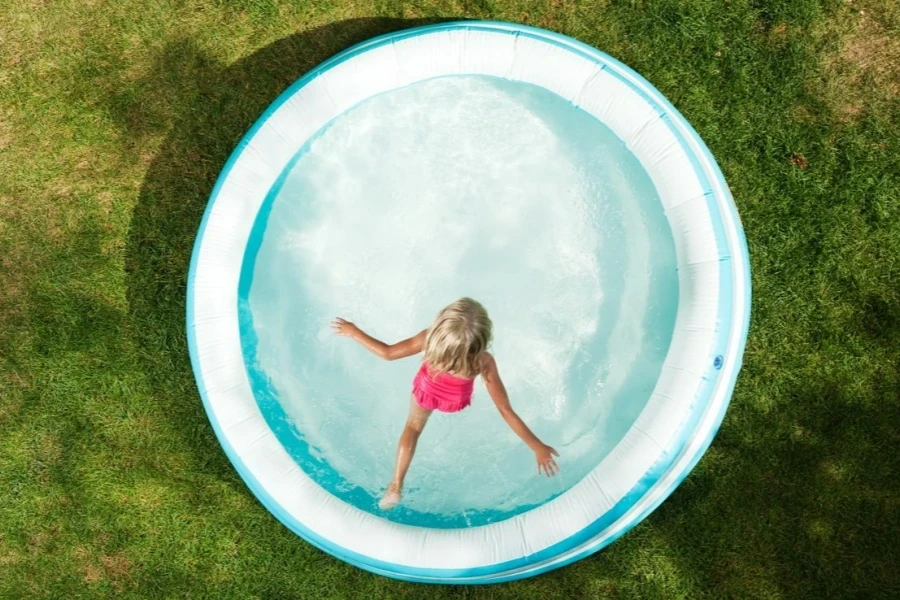Table of Contents
● Introduction
● Types and Usage of Inflatable Pools
● Market Overview for Inflatable Pools in 2025
● Factors to Consider When Selecting Inflatable Pools
● Top Inflatable Pools and Features
● Conclusion
Introduction
Inflatable pools have become a popular and versatile solution for outdoor leisure, offering a wide range of options for both residential and commercial use. In 2025, these pools are designed to cater to varying needs, from small, portable models for limited spaces to larger, luxury pools ideal for gatherings and relaxation. They provide an affordable and convenient alternative to traditional pools, with easy setup and maintenance. As demand grows, choosing the right inflatable pool means understanding the latest features, quality materials, and suitable designs that meet the evolving needs of customers. Making informed decisions can significantly impact satisfaction and long-term value, ensuring that businesses stay competitive in this expanding market.
Types and Usage of Inflatable Pools

Family-sized pools for large groups and gatherings
Inflatable pools designed for families offer spacious areas for large groups to gather and enjoy. These pools typically range from 8 to 12 feet in length, providing ample room for multiple users. The larger designs allow for a variety of water activities, from lounging to playing, making them ideal for family gatherings or small social events. Easy to inflate and set up, these pools serve as a convenient alternative to permanent structures, offering flexibility and affordability. While some models may include additional features like built-in seating or drink holders, they are largely designed for relaxation and fun in the sun.
Portable pools for small spaces and easy transport
For those with limited space or who require a portable solution, smaller inflatable pools are an excellent choice. These pools, typically around 6 feet in diameter, are ideal for backyards or even patios with limited room. Their compact size allows for easy storage and transport, making them suitable for both residential and temporary setups. These models are popular among individuals seeking a quick and accessible way to cool off during the warmer months. The simple, no-fuss design ensures that the pool can be set up in a matter of minutes, providing a hassle-free experience for individuals or small families.
Luxury and adult-focused pools with added features
For a more indulgent experience, luxury inflatable pools cater to those looking for high-end features and comfort. These pools often come with added perks such as built-in seating, multi-chamber designs for added durability, and even shade structures. Perfect for relaxation or entertaining small groups, these models provide an upscale solution without the need for permanent installation. Many luxury pools are designed with aesthetically pleasing features, such as soft-touch interiors or modern color schemes, making them suitable for adults who want to enjoy a premium experience in their backyard.
Market Overview for Inflatable Pools in 2025

According to Pro Market Reports, the inflatable pool market is currently valued at USD 1.78 billion in 2023 and is projected to reach USD 2.90 billion by 2032, growing at a compound annual growth rate (CAGR) of 7.20% from 2023 to 2032. This growth is driven by rising disposable incomes, the increasing popularity of outdoor recreational activities, and the appeal of inflatable pools in urban spaces where traditional pools are impractical. Innovations in design, such as inflatable spas and pools with enhanced safety features, are broadening the market’s appeal. Additionally, the flexibility, ease of setup, and cost-effectiveness of inflatable pools are contributing to their rising demand, especially in regions with space constraints or seasonal climates.
Growth trends in the inflatable pool market
The inflatable pool market is witnessing significant growth, fueled by increased consumer interest in affordable, convenient outdoor leisure options. Over recent years, these pools have gained popularity due to their low cost, easy installation, and space-saving qualities. As outdoor activities become more integral to home-based entertainment, particularly in regions with warm climates, the demand for inflatable pools has surged. Families, especially those with small children, are opting for these pools as a safe and fun alternative to expensive and permanent in-ground pools. In addition, the evolving trend of staycations has heightened the desire for outdoor recreation at home, driving further interest in inflatable pool options.
Innovations in materials and design have also contributed to the growth of the market. Advances in PVC technology and reinforced fabrics have improved the durability and aesthetics of inflatable pools, addressing previous concerns about wear and tear. Manufacturers are offering more customized options, including varying sizes, shapes, and colors, to cater to diverse consumer tastes. The increased availability of built-in features, such as cup holders, seats, and splash zones, has enhanced their appeal. As a result, the inflatable pool market is poised to expand in 2025, benefiting from both technological improvements and shifting consumer preferences.
Economic impact and the competitive pool market
The economic impact of the inflatable pool market is significant, contributing to job creation and driving revenue in manufacturing, distribution, and retail sectors. As demand for inflatable pools rises, manufacturers and suppliers are investing in production capabilities to meet consumer expectations. This growth has had a positive ripple effect on various industries, particularly logistics and warehousing, as companies manage higher volumes of products to fulfill online orders. Moreover, seasonal peaks in demand, especially during the summer months, have given rise to niche markets such as pool rentals for special events, further supporting the broader economy.
The competitive landscape of the inflatable pool market remains highly fragmented, with numerous players competing in both the budget and premium segments. Established brands are constantly innovating, introducing new features such as enhanced safety mechanisms and multifunctional designs that serve both as play areas and relaxation zones. However, new entrants continue to challenge larger players, particularly in the e-commerce space where the barrier to entry is lower. The rise of online shopping has intensified competition, allowing smaller brands to reach wider audiences. Companies are focusing on value-added features, customer satisfaction, and after-sales services to gain an edge in this competitive market.
Factors to Consider When Selecting Inflatable Pools

Size and durability: Ensuring long-term value
The size of an inflatable pool should align with its intended use, whether for large gatherings or personal relaxation. It is essential to select a pool that fits the available space while ensuring safety and comfort. Durability plays a key role in the pool’s long-term value, with high-quality models made from puncture-resistant materials and reinforced seams offering greater protection against wear and tear. Additionally, UV-resistant coatings help extend the lifespan of the pool by reducing the impact of sunlight and exposure to outdoor elements. Choosing a durable and appropriately sized inflatable pool ensures consistent performance season after season.
Ease of setup and maintenance: Enhancing user experience
Inflatable pools should be simple to set up and maintain to maximize the overall user experience. Pools with easy-inflate features, such as electric air pumps, streamline the setup process, making it faster and more efficient. Maintenance is also a key consideration, with pools featuring built-in filtration systems, easy-drain valves, and detachable filters helping to reduce cleaning time and effort. Pools that require less maintenance are particularly attractive, as they allow users to focus more on enjoying the pool rather than managing its upkeep.
Design, features, and aesthetics: Meeting modern needs
Modern inflatable pools offer a wide range of designs that cater to diverse preferences, from basic shapes to more elaborate structures with added features. Aesthetics have become a significant factor in the selection process, with pools now offering vibrant colors, intricate patterns, and even lighting options for a more luxurious experience. In addition to style, many inflatable pools are equipped with functional features like adjustable water jets, seating areas, or built-in speakers, which enhance comfort and usability. Buyers looking for a balance of form and function should consider pools that provide both aesthetic appeal and practical enhancements for an elevated outdoor experience.
Top Inflatable Pools and Features

Family-oriented pools: Best models for large groups
For large groups and family gatherings, inflatable pools designed to accommodate several people are in high demand. These models often feature larger surface areas, comfortable seating, and durable construction to withstand continuous use. Many of these pools are designed with extra-wide walls, making them ideal for family pool parties or group activities. The added space allows for multiple users to swim, splash, and relax simultaneously, ensuring that everyone has room to enjoy the water.
Beyond size, family-oriented pools for 2025 are incorporating innovative features like built-in cup holders, extra-large drain valves for faster water removal, and reinforced sides to prevent collapsing or deformation. These pools are typically designed for ease of use, allowing for quick setup and takedown. With the inclusion of safety features such as non-slip surfaces and higher weight limits, these pools provide both functionality and safety, making them a solid choice for large families looking to maximize their outdoor fun.
Compact and portable options: Ideal for tight spaces
For those with smaller backyards or limited space, compact and portable inflatable pools are the perfect solution. These pools often come in smaller sizes but are still designed to deliver a satisfying experience, whether for individual use or for a couple. They are lightweight and easy to transport, making them an excellent option for those who want to enjoy a pool without dedicating a large area to it. Many compact models can be easily deflated and stored away when not in use, freeing up space for other outdoor activities.
In addition to portability, these inflatable pools often come with unique features that maximize comfort and usability despite their smaller size. Some include integrated air chambers for added stability, while others offer quick inflation and deflation systems to save time. These pools are also becoming more aesthetically pleasing, with sleek, modern designs that fit seamlessly into smaller outdoor spaces. With innovation and practicality at their core, compact inflatable pools remain an appealing option for consumers seeking flexibility.
Premium models: High-end features for luxury and comfort
For those seeking an elevated pool experience, premium inflatable pools are an attractive choice. These models often boast high-end features such as built-in LED lighting, inflatable loungers, and even integrated water filtration systems. Many of these pools are designed for adults and provide a relaxing and luxurious experience with added amenities such as adjustable air pressure, water jets, and even cup holders. They allow users to enjoy a spa-like experience at home, offering both luxury and relaxation in a compact, easy-to-set-up format.
Premium inflatable pools also stand out for their durability and the quality of materials used in construction. Unlike traditional budget models, these high-end options often feature reinforced sidewalls, puncture-resistant materials, and UV-resistant coatings, ensuring longevity and resistance to wear and tear. As demand for more sophisticated outdoor solutions grows, premium inflatable pools are becoming a desirable option for those looking to create a private oasis in their backyard.
Conclusion

As the inflatable pool market continues to grow, selecting the right product for 2025 will depend on key factors such as durability, ease of setup, and design. Businesses will need to consider consumer preferences for family-friendly features, portability, and luxury options. Ensuring a product line that aligns with evolving trends—like eco-friendly materials and enhanced user experiences—will be crucial for maintaining competitiveness. By prioritizing innovation and keeping an eye on market shifts, companies can make informed decisions and select products that meet both consumer demands and industry standards.




